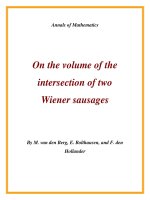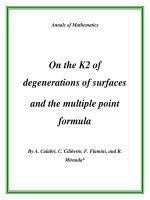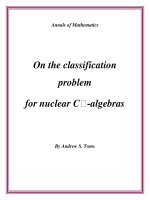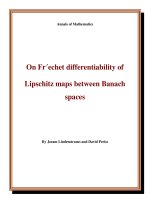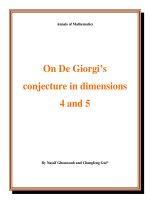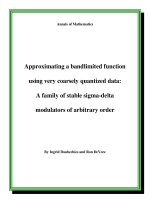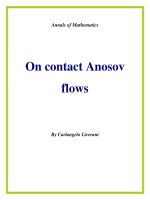Đề tài " On a coloring conjecture about unit fractions " ppt
Bạn đang xem bản rút gọn của tài liệu. Xem và tải ngay bản đầy đủ của tài liệu tại đây (153.2 KB, 13 trang )
Annals of Mathematics
On a coloring conjecture
about unit fractions
By Ernest S. Croot III
Annals of Mathematics, 157 (2003), 545–556
On a coloring conjecture
about unit fractions
By Ernest S. Croot III
Abstract
We prove an old conjecture of Erd˝os and Graham on sums of unit fractions:
There exists a constant b>0 such that if we r-color the integers in [2,b
r
], then
there exists a monochromatic set S such that
n∈S
1/n =1.
1. Introduction
We will prove a result on unit fractions which has the following corollary.
Corollary. There exists a constant b so that for every partition of the
integers in [2,b
r
] into r classes, there is always one class containing a subset
S with the property
n∈S
1/n =1.
In fact, we will show that b may be taken to be e
167000
,ifr is sufficiently
large, though we believe that b may be taken to be much smaller; also note
that b cannot be taken to be smaller than e, since the integers in [2,e
r−o(r)
]
can be placed into r classes in such a way that the sum of reciprocals in each
class is just under 1.
This corollary implies the result mentioned in the abstract and so resolves
an unsolved problem of Erd˝os and Graham, which appears in [2], [3], and [5].
We will need to introduce some notation and definitions in order to state
the Main Theorem, as well as the propositions and lemmas in later sections:
Foragiven set of integers C, let Q
C
denote the set of all the prime power
divisors of elements of C, and let Σ(C)=
q∈Q
C
1/q. Define C(X, Y ; θ)to
be the integers in [X, Y ] all of whose prime power divisors are ≤ X
θ
, and let
C
(X, Y ; θ)bethose integers n ∈C(X, Y ; θ) such that ω(n) ∼ Ω(n) ∼ log log n,
where ω(n) and Ω(n) denote the number of prime divisors and the number of
prime power divisors of n, respectively.
Our Main Theorem, then, is as follows.
546 ERNEST S. CROOT III
Main Theorem. Suppose C ⊂C
(N,N
1+δ
; θ), where θ, δ > 0, and δ+θ<
1/4.IfN
θ,δ
1 and
n∈C
1
n
> 6,
then there exists a subset S ⊂ C for which
n∈S
1/n =1.
To prove the corollary, we will show in the next section that for r suffi-
ciently large,
(1.1)
n∈C
(N,N
1+δ
;1/4.32)
1
n
> 6r,
where N = e
163550r
and N
1+δ
= e
166562r
.Thus, if we partition the integers
in [2,e
167000r
]intor classes, then for r sufficiently large, one of the classes C
satisfies the hypotheses of the Main Theorem, and so our corollary follows.
The key idea in the proof of the Main Theorem is to construct a subset of
C with usable properties. These are summarized in the following proposition
which is proved in Section 4.
Proposition 1. Suppose C ⊂C
(N,N
1+δ
; θ) with δ + θ<1/4, and sup-
pose
n∈C
1
n
> 6.
Then there exists a subset D ⊂ C such that
(1.2)
n∈D
1
n
∈ [2 − 3/N, 2),
and which has the following property: If I is an interval of length N
3/4
for
which there are less than N
1−θ
/(log log N)
2
elements of D that do not divide
any element of I, then every element of D divides one single element of I.
The sum of the reciprocals of the elements of D is < 2by(1.2), so if there
is a subset S of D for which
n∈S
1/n is an integer then that sum equals 1 or
S is the empty set. Now if x is an integer and
P := lcm{n ∈ D},
then (1/P)
h (mod P )
e(hx/P )=1ifx/P is an integer, and is 0 otherwise,
where e(t)=e
2πit
. Combining these remarks we deduce that
ON A COLORING CONJECTURE ABOUT UNIT FRACTIONS
547
(1.3) #
S ⊂ D :
n∈S
1/n =1
=
1
P
−P/2<h≤P/2
E(h)
− 1,
where
E(h):=
n∈D
(1 + e(h/n)) .
Now,
(1.4) E(h)=e
h
2
n∈D
1
n
2
|D|
n∈D
cos(πh/n)
,
so that
Arg(E(h)) = πh
n∈D
1
n
∈ (2πh − π/2, 2πh + π/2),
if |h| is an integer <N/6; and therefore E(h)+E(−h) > 0 for this case. Thus
we deduce that
|h|<N/6
E(h) >E(0)=2
|D|
.
For h in the range N/6 ≤|h|≤P/2, we will use Proposition 1 to show
that
(1.5) |E(h)| <
2
|D|−1
P
,
so that, by the last two displayed equations,
1
P
−P/2<h≤P/2
E(h) >
1
P
2
|D|
−
N/6≤|h|≤P/2
2
|D|−1
P
>
2
|D|−1
P
> 1,
since |D|≥
n∈D
N/n ≥ 2N − 3, and since
(1.6) P<
N
θ
π(N
θ
)
e
(1+o(1))N
θ
= o
2
|D|
,
by the prime number theorem. Theorem 1 then follows.
We will now see how (1.5) follows from Proposition 1. If |h|∈[N/6,P/2]
then I := [h − N
3/4
/2,h+ N
3/4
/2] does not contain any integer divisible by
every element of D, since P = lcm
n∈D
n is bigger than every element in I.
Therefore, by Proposition 1, there are at least N
1−θ−o(1)
elements n ∈ D
which do not divide any integer in I.Forsuch n we will have that ||h/n|| >
N
3/4
/2n>1/(2N
1/4+δ
) (where ||t|| denotes the distance from t to the nearest
548 ERNEST S. CROOT III
integer to t). Thus,
n∈D
cos(πh/n)
<
cos
π
2N
1/4+δ
N
1−θ−o(1)
<
1 −
π
2
8N
1/2+2δ
+ O
1
N
N
1−θ−o(1)
< exp
−(π
2
/8)N
1/2−2δ−θ−o(1)
<
1
2P
,
by (1.6) since δ + θ<1/4, and so (1.5) follows from (1.4).
The rest of the paper is dedicated to proving Proposition 1.
2. Normal integers with small prime factors
We will need the following result of Dickman from [1].
Lemma 1. Fix u
0
> 0.Forany u,0<u<u
0
we have
#{n ≤ x : p|n ⇒ p ≤ x
1/u
}∼xρ(u),
where ρ(u) is the unique, continuous solution to the differential difference equa-
tion
ρ(u)=1, if 0 ≤ u ≤ 1
uρ
(u)=−ρ(u − 1), if u>1.
From this lemma and partial summation we have, for a fixed u and δ,
N<n<N
1+δ
p
a
||n⇒p
a
≤N
1/u
1
n
∼
log N
u
u(1+δ)
u
ρ(w)dw.
Using this, a numerical calculation shows for N = exp(163550r), θ =1/u =
1/4.32, and δ =1/4 − θ − 0.0001 that
N<n<N
1+δ
p
a
||n⇒p
a
≤N
θ
1
n
> 6.0001r.
Combining this with the well-known fact that almost all integers n ≤ x satisfy
ω(n) ∼ Ω(n) ∼ log log n,sothat
N<n<N
1+δ
ω(n)orΩ(n)∼log log N
1
n
= o(r),
we have that (1.1) follows.
ON A COLORING CONJECTURE ABOUT UNIT FRACTIONS
549
3. Technical lemmas and their proofs
Lemma 2. If w
1
and w
2
are distinct integers which both lie in an interval
of length ≤ N , then
p
a
|gcd(w
1
,w
2
)
1
p
a
<
p|gcd(w
1
,w
2
)
1
p
+ O(1) < (1 + o(1)) log log log N.
Proof of Lemma 2. Let G =gcd(w
1
,w
2
). We have that G ≤|w
1
−w
2
| <N,
since G||w
1
− w
2
|; also, ω(G)=o(log N), since ω(n)=o(log N) uniformly for
n ≤ N.Now,bythe Prime Number Theorem, we have π(log N log log N)
log N>w(G), for N sufficiently large, and so
p|G
p prime
1
p
<
p≤log N log log N
p prime
1
p
< (1 + o(1)) log log log N.
Lemma 3. If H ⊂C(N,N
1+β
; 1), β>0, satisfies
n∈H
1/n > 1/(log N)
o(1)
,
and ω(n) ∼ log log n, for every n ∈ H, then
Σ(H) > (e
−1
− o(1)) log log N.
Proof of Lemma 3. From the hypotheses of the lemma, together with the
fact that t! > (t/e)
t
for t ≥ 1, we have that
1
(log N)
o(1)
<
n∈H
1
n
<
n : p
a
|n⇒p
a
∈Q
H
ω(n)∼log log n∼log log N
1
n
<
t∼log log N
Σ(H)
t
t!
<
t∼log log N
Σ(H)e
t
t
=
Σ(H)(e + o(1))
log log N
(1+o(1)) log log N
,
and so Σ(H) satisfies the conclusion to Lemma 3.
4. Proof of Proposition 1
Before we prove Proposition 1, we will need two more propositions.
Proposition 2.Suppose that J ⊂C(N, ∞; θ), where θ<1, and
n∈J
1/n
≥ α>ν.IfN
α,ν,θ
1, then there is a subset E ⊂ J such that
(4.1)
n∈E
1
n
∈
ν −
1
N
,ν
;
550 ERNEST S. CROOT III
and,
(4.2)
n∈E
q|n
1
n
>
min{ν, α − ν}
5q log log N
, for all q ∈Q
E
.
Proposition 3. Suppose that E ⊂C
(N,N
1+δ
; θ), 0 <θ<1/4, satisfies
(4.1) and (4.2). If all but at most N
1−θ
/(log log N)
2
elements of E divide some
element of an interval I := [h − N
3/4
/2,h+ N
3/4
/2], then either
A. There is a single integer in I divisible by all elements of E, or
B. There exist distinct integers w
1
,w
2
∈ I, such that
(4.3) #{n ∈ E : n
w
1
and n
w
2
} <
2N
1−θ
(log log N)
2
,
(4.4) lcm{n ∈ E} = lcm{q ∈Q
E
}|w
1
w
2
,
and
(e
−1
− o(1)) log log N<
q|w
i
q∈Q
E
1
q
(4.5)
< (1 − e
−1
+ o(1)) log log N, for i =1and 2.
These propositions will be proved in the next two sections of the paper.
To prove Proposition 1, we iterate the following procedure:
1. Set j =0and let C
0
:= C.
2. Use Proposition 2 with J = C
j
, α =
n∈C
j
1/n > 2,and ν =2,to
produce a subset E satisfying (4.1) and (4.2).
3. If case A of Proposition 3 holds for every real number h satisfying the
hypotheses of Proposition 3, then we can let D := E, and Proposition 1 is
proved.
4. If there is some h for which case B holds, then, by (4.3), we have for
either i =1ori =2that
n∈E
n|w
i
1
n
≥
1
2
n∈E
n|w
1
or w
2
1
n
>
1
2
n∈E
1
n
−
2N
1−θ
(log log N)
2
N
> 1 − O
1
N
θ
(log log N)
2
.
ON A COLORING CONJECTURE ABOUT UNIT FRACTIONS
551
Without loss of generality, assume that the inequality holds for i =1,and let
E
∗
be those elements of E which divide w
1
.
5. Use Proposition 2 again, but this time with J = E
∗
, α =
n∈E
∗
1/n,
and ν =2/3, to produce a set D
j
satisfying (4.1) and (4.2) with E = D
j
.From
(4.5) we have that Σ(D
j
) < Σ(E
∗
) < (1 − e
−1
+ o(1)) log log N.
6. Set C
j+1
= C
j
\ D
j
.If
n∈C
j+1
1
n
≤ 8/3, then STOP; else, increment
j by1and go back to step 2.
When this procedure terminates, we are either left with a set D from step 3
which proves our proposition, or we are left with six disjoint sets, D
1
, ,D
6
⊂
C
(N,N
1+δ
; θ) satisfying
n∈D
i
1/n ∈ [2/3 − 1/N, 2/3) and
(4.6) (e
−1
− o(1)) log log N<Σ(D
i
) < (1 − e
−1
+ o(1)) log log N).
The lower bound for Σ(D
i
) follows from Lemma 3 with H = D
i
, and the upper
bound is as given in step 5.
We claim that there exist three of our sets, D
a
,D
b
,D
c
such that if L =
Q
D
a
∩Q
D
b
∩Q
D
c
, then Σ(L) log log N.For any such triple, we will show
that letting D = D
a
∪ D
b
∪ D
c
satisfies the conclusions of Proposition 1.
To show that D
a
,D
b
,D
c
exist, let R be the set of prime powers ≤ N
θ
which are contained in at least three of the sets Q
D
1
, ,Q
D
6
. Then, by (4.6),
Σ(R) >
1
4
6
i=1
Σ(D
i
) − 2
p
a
≤N
θ
p prime
1
p
a
>
1
4
6
e
− 2 − o(1)
log log N log log N.
Thus, since there 20 =
6
3
triples of sets chosen from {D
1
, ,D
6
}, there is
at least one such triple which gives Σ(L) > Σ(R)/20 log log N.
Now, letting D = D
a
∪ D
b
∪ D
c
certainly satisfies (1.2). Suppose that
the number of elements of D which do not divide any element of I is at most
N
1−θ
/(log log N)
2
. Then, the hypotheses of Proposition 3 hold for E = D
a
,D
b
,
and D
c
. Case B of Proposition 3 cannot hold for E = D
a
(or D
b
, or D
c
), else
(4.5) and (4.6) would give us
q|gcd(w
1
,w
2
)
q∈Q
D
a
1
q
>
q|w
1
q∈Q
D
a
1
q
+
q|w
2
q∈Q
D
a
1
q
−
q∈Q
D
a
1
q
>
3
e
− 1 − o(1)
log log N log log N,
which, by Lemma 2, would imply that w
1
= w
2
.Thus, case A of Proposition 3
holds for E = D
a
,D
b
, and D
c
: Let W
a
, W
b
, and W
c
be the single integer
552 ERNEST S. CROOT III
in I dividing all elements of D
a
,D
b
, and D
c
, respectively, and thus they are
all divisible by every element of L. Since Σ(L) log log N,wehave, from
Lemma 2, that W
a
= W
b
= W
c
= W , for some W ∈ I. Proposition 1 now
follows since lcm{n ∈ D}|W .
5. Proof of Proposition 2
To prove Proposition 2 we will need the following lemma.
Lemma 4. Suppose S is a set of integers, all of whose prime power divisors
are less than N, which satisfies
n∈S
1/n ≥ ρ>µ.IfN is large in terms of
ρ and µ, then there exists a subset T ⊆ S for which
(5.1)
n∈T
1
n
>µ, and
n∈T
q|n
1
n
>
ρ − µ
2q log log N
, for all q ∈Q
T
.
Proof. We form a chain of subsets S
0
:= S ⊃ S
1
⊃···⊃T := S
k
as
follows: given S
i
, let q
i
be the smallest prime power such that
n∈S
i
q
i
|n
1
n
<
ρ − µ
2q
i
log log N
,
if such q
i
exists, and then let S
i+1
= S
i
\{n ∈ S
i
: q
i
|n}.Ifnosuch q
i
exists,
then let k = i and T = S
i
= S
k
.Wehave that
n∈T
1
n
>ρ−
ρ − µ
2 log log N
p
a
≤N
p prime
1
p
a
>µ,
for N large enough, since
p
a
≤N
1/p
a
< 2 log log N.
Proof of Proposition 2. We first use Lemma 4 with ρ = α, µ = ν, and
S = J,toproduce a set D
0
= T satisfying (5.1). Thus, (4.2) holds for E = D
0
.
We will construct a chain of subsets D
0
⊃ D
1
⊃ D
2
⊃ ···, where each
set D
j
satisfies (4.2) with E = D
j
= D
j−1
\{w
j
}, where w
j
is some yet to be
chosen element of D
j−1
.Ifwecan do this then we will eventually reach a set
D
k
which also satisfies (4.1), since each w
j
≥ N, and so the proposition will
be proved.
Suppose (4.2) is satisfied for E = D
j−1
, for j ≥ 1. Take Lemma 4 with
S = D
j−1
, ρ = ν, and µ = ν/2, and let w
j
be the smallest element of T . Let
q ∈Q
D
j
.Ifq w
j
, then
n∈D
j
q|n
1
n
=
n∈D
j−1
q|n
1
n
>
min{ν, α − ν}
5q log log N
,
ON A COLORING CONJECTURE ABOUT UNIT FRACTIONS
553
by hypothesis. On the other hand, if q|w
j
, then, by (5.1), we get
n∈D
j
q|n
1
n
≥
n∈T
q|n
1
n
−
1
w
j
>
ν
4q log log N
−
1
N
>
ν
5q log log N
,
since q ≤ N
θ
, with θ<1, and ν 1, and so (4.2) holds for E = D
j
.
6. Proof of Proposition 3
Let E
I
denote the set of integers in E which divide an integer in I. Then
we have, by hypothesis, that |E
I
| > |E|−N
1−θ
/(log log N)
2
.Ifq ∈Q
E
, then
(6.1)
n∈E
I
q|n
1
n
>
n∈E
q|n
1
n
−
N
1−θ
N(log log N)
2
1
q log log N
,
since q ≤ N
θ
and E satisfies (4.2). Thus, we have that Q
E
I
= Q
E
.
We will show at the end of this section that for all q ∈Q
E
, there exists
an integer qd ∈ [N
3/4
,N
3/4+θ
] such that
(6.2)
n∈E
I
qd|n
1
n
θ
1
qd(log log N)
2
,
where ω(d) ≤ ω
0
= log log N/ log log log log N, for N sufficiently large, and all
the prime divisors of d are greater than y := exp((1/8 − θ/2) log N/ log log N).
Fornow, let us assume that this is true and let qd satisfy (6.2) for a given
q ∈Q
E
. All the elements of E
I
which are divisible by qd must divide the same
number n(q) ∈ I, since otherwise there are two distinct numbers n
1
(q) and
n
2
(q) which differ by ≤ N
3/4
but yet are both divisible by qd > N
3/4
, which
is impossible. We will show that as a consequence of this and (6.2),
(6.3)
p
a
|n(q)
p
a
∈Q
E
1
p
a
>
1
e
− o(1)
log log N.
This implies there are at most two distinct values of n(q), for all q ∈Q
E
: for if
there were three prime powers q
1
,q
2
,q
3
with n(q
1
),n(q
2
),n(q
3
) distinct, then,
by Lemma 2,
p
a
|gcd(w
1
,w
2
)
1
p
a
log log log N,
554 ERNEST S. CROOT III
so that, by (6.3),
log log N + O(1) =
p
a
≤N
p prime
1
p
a
> Σ(E) ≥
3
i=1
p
a
|n(q
i
)
p
a
∈Q
E
1
p
a
+ O(log log log N)
> (3e
−1
− o(1)) log log N,
which is impossible.
If there is just one value for n(q), for all q ∈Q
E
, then w = n(q) satisfies
case A of Proposition 3: Otherwise, there are two possible values for n(q), call
them w
1
and w
2
, which satisfy (4.4). The lower bound in (4.5) comes from
(6.3). Moreover,
q|w
1
q∈Q
E
1
q
≤
p
a
≤N
1
p
a
−
q|w
2
q∈Q
E
1
q
+
p
a
|gcd(w
1
,w
2
)
1
p
a
≤ (1 − e
−1
+ o(1)) log log N,
which implies the upper bound in (4.5) (note: the same upper bound holds for
w
2
), using the Prime Number Theorem (6.3), and Lemma 2, respectively.
If w
1
,w
2
fail to satisfy (4.3), then
#{n ∈ E
I
: n w
1
or w
2
} > #{n ∈ E : n w
1
or w
2
}−
N
1−θ
(log log N)
2
>
N
1−θ
(log log N)
2
.
Since there are ≤ N
3/4
integers in I, there must exist an integer x ∈ I,x = w
1
or w
2
, for which
(6.4) #{n ∈ E
I
: n|x}
N
1−θ
N
3/4
(log log N)
2
=
N
1/4−θ
(log log N)
2
.
Therefore,
lcm
n∈E,n|x
n ≤ gcd(x, w
1
w
2
)
≤ gcd(x, w
1
)gcd(x, w
2
) < (x − w
1
)(x − w
2
) <N
3/2
;
but then we have
#{n ∈ E : n|x}≤τ
lcm
n∈E,n|x
n
≤ max
l≤N
3/2
τ(l)=N
o(1)
,
which contradicts (6.4), and so (4.3) follows. Thus, the proof of Proposition 3
is complete once we establish (6.2) and (6.3).
To show (6.3), we observe that every integer m ∈ F = {n/qd : n ∈ E,
qd|n} satisfies ω(m) ∼ log log N, since ω(qd) ≤ ω
0
= o(log log N ), and since
E ⊂C
(N,N
1+δ
; θ). From this and (6.2), F satisfies the hypotheses of Lemma 3
with H = F .Thus, Σ(F ) > (e
−1
− o(1)) log log N, which implies (6.3).
ON A COLORING CONJECTURE ABOUT UNIT FRACTIONS
555
We will now establish (6.2). First, we claim that for every n ∈ E, where
q|n and q ∈Q
E
, there exists a divisor qd ∈ [N
3/4
,N
3/4+θ
], where p|d implies
p>y(though it may not be the case that ω(d) ≤ ω
0
). To show this, we
construct such a d by adding on prime factors one at a time, until qd is in this
interval. There are enough prime factors >yto do this, since for N
1we
have
p
a
||n/q
p>y
p
a
>
n
q
p
a
||n
p≤y
p
a
>
n
qy
Ω(n)
>
N
N
θ
exp
(1/8−θ/2)Ω(n) log N
log log N
>N
3/4
,
for N sufficiently large, since Ω(n) ∼ log log N.
If (6.2) fails to hold for all d ∈ [N
3/4
/q, N
3/4+θ
/q] with ω(d) ≤ ω
0
, then
we would have by (4.2) and Mertens’ theorem that,
(6.5)
min{ν, α − ν}
5q log log N
<
n∈E
q|n
1
n
<
N
3/4
/q≤d≤N
3/4+θ
/q
p|d⇒p>y
n∈E
qd|n
1
n
<
N
3/4
/q≤d≤N
3/4+θ
/q
p|d⇒p>y
ω(d)<ω
0
n∈E
qd|n
1
n
+
d:p|d⇒y<p<N
ω(d)≥ω
0
m≤N
1+δ
/qd
(n=mqd)
1
qdm
= o
1
q(log log N)
2
d:p|d⇒y<p<N
1
d
+O
log N
q
d:p|d⇒y<p<N
w(d)≥ω
0
1
d
.
Now,
d:p|d⇒y<p<N
1
d
≤
y<p<N
p prime
1 −
1
p
−1
log N
log y
log log N,
by Mertens’ theorem, and for k = (log log log N)
3
,wehave, again by Mertens’
theorem,
d:p|d⇒y<p<N
ω(d)≥ω
0
1
d
d:p|d⇒y<p<N
k
ω(d)−ω
0
d
=
1
k
ω
0
y<p<N
p prime
1+
k
p − 1
=
1
k
ω
0
log N
log y
k+o(k)
1
log
2
N
.
Combining these two applications of Mertens’ theorem with (6.5), we arrive
at a contradiction. Thus, there must exist a d ∈ [N
3/4
/q, N
3/4+θ
/q] satisfying
(6.2), with ω(d) ≤ ω
0
= o(log log N).
556 ERNEST S. CROOT III
7. Acknowledgements
First, and foremost, I would like to thank my advisor Andrew Granville
for his encouragement and for helping me edit this paper to get it into its
current form. I would also like to thank P. Erd˝os and R. L. Graham for the
wonderful questions.
University of California, Berkeley, CA
E-mail address:
References
[1] K. Dickman,Onthe frequency of numbers containing prime factors of a certain relative
magnitude, Arkiv. Math. Astr. Fys. 22 (1930), 1–14.
[2]
P. Erd
˝
os and R. L. Graham, Old and new problems and results in combinatorial number
theory, Enseign. Math. (1980), 30–44.
[3]
R. K. Guy, Unsolved Problems in Number Theory, Second edition, Springer-Verlag, New
York, 1994, 158–166.
[4]
H. Halberstam and H E. Richert, Sieve Methods, London Math. Soc. Monographs, No.
4 (1974), Academic Press, New York, 1974.
[5]
H. L. Montgomery,Ten lectures on the interface between analytic number theory and
harmonic analysis, C.B.M.S. Reg. Conference Series Math. 84, Amer. Math. Soc., Prov-
idence, RI, 1994.
(Received May 16, 2001)
